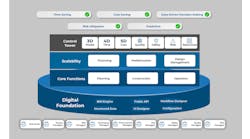By: Tony McClellan
The mission of the Indiana Department of Transportation (InDOT) is to “plan, build, maintain and operate a superior transportation system enhancing safety, mobility and economic growth.” In an effort to improve the safety and mobility of the traveling public during snow and ice events, InDOT has added several technologies to the maintenance supervisor’s toolbox.
These technologies include an alphabet soup of acronyms like MDSS, AVL, RWIS and MDC. The tools are useful when used independently, but the real power of these tools is realized when they are combined.
In 1990, InDOT began installing road weather information systems (RWIS) to give management and front-line supervisors real-time information on factors such as air and pavement temperatures, wind speeds, chemical concentrations and historical data. The first installations were placed in northern Indiana, where lake-effect snows and winter weather are the harshest. In spring 2003, InDOT started a deployment of RWIS to provide coverage throughout the state. InDOT plans to continue to add RWIS stations to its snow- and ice-fighting arsenal for the future.
Collecting ingredients
During the late 1990s, new concepts in snow and ice technology were being discussed by a new combination of weather and road experts at meetings with the two groups. Soon after, the Federal Highway Administration (FHWA) sponsored a research project that combined these ideas in a concept called the maintenance decision support system (MDSS). An MDSS in the context of this article is a system that integrates current weather and maintenance and road condition information with forecasted weather and road surface conditions to recommend road treatment options. The federal prototype focused on strategic and tactical decisions that are made preparing for and fighting snow and ice events.
The primary focus was on the strategic portion of fighting snow and ice. In early 2003, InDOT joined a pooled-fund study group to look at the use of an MDSS. The pooled-fund study research project was begun after a few states discovered that there was a desire to take a harder look at the tactical side of snow and ice fighting. The study group has since expanded to at least 14 states that are participating, including California, Colorado, Iowa, Kansas, Kentucky, Minnesota, New Hampshire, New York, Nebraska, North Dakota, South Dakota, Virginia and Wyoming. Meridian Environmental Technology Inc. serves as the principal contractor for this MDSS pooled-fund study. An MDSS should recommend the most effective treatments and the appropriate time to apply those treatments based upon user-defined parameters, which include route cycle time, maximum and minimum application rates and available labor resources. As with most decision-support systems, the MDSS becomes more effective as more relevant data is supplied to the system.
InDOT is relatively new to automated vehicle location (AVL) technology. AVL typically uses satellites to locate the vehicle geographically and transmits the location through mobile communications to a user who can see where the vehicle is located. The department has had an interest in the technology and had used it with some of their Hoosier Helpers, but a major snowplow deployment was difficult to justify for a device that just indicated where the truck was located. With the onset of mobile data collection (MDC) technology, and the desire to provide more data to the MDSS, AVL in combination with MDC provided a benefit worth the cost of the technology.
Preparing the dish
In 2006, InDOT began a research project with Purdue University to determine the best communication method for the department to transfer AVL/MDC snowplow data to InDOT servers. The project investigated 800-MHz cellular and satellite communications. It was quickly determined that satellite communications were too expensive and not necessary in a state with excellent radio and cellular communications.
The project is still in process, but both forms of data transfer were found to be viable, and each came with pros and cons. Large amounts of data transfer were limited on the radio network, but the system was already in place. Cellular communications could handle the larger amounts of data, including pictures, but a monthly fee is associated with this form of data transfer.
InDOT installed 12 commercial AVL/MDC units made by IWAPI Inc. of Golden, Colo., in October 2007. The devices included a 7-in. touch screen and small wafer camera used to show images in front of the snowplow. The devices were installed to help feed needed data to the MDSS for processing. The touch screen is used to enter data including weather observations and to give the driver an opportunity, when stopped, to see route-specific forecasts for the next two hours from the MDSS. The driver also has the ability to see weather radar on the touch screen when stopped. After the initial installation problems were corrected, the IWAPI AVL/MDC worked seamlessly with the MDSS to both provide data to the MDSS and provide forecasts and treatment recommendations back to drivers and supervisors.
Indiana, like most states, is facing budget constraints as fuel-tax revenues fall with the reduction of fuel consumption. The state is looking to new technologies to help reduce snow and ice expenditures while still providing a constant level of service. The use of MDSS in conjunction with AVL/MDC should help the state accomplish this task. Indiana is planning to aggressively introduce the MDSS with AVL/MDC throughout the state in the 2008-09 winter season. The state plans to install over 120 AVL/MDC units in the fall for use this winter. More units will be introduced to the fleet in the following years. To successfully implement this plan, the state also will have to address several issues that were discovered during the 2007-08 trial.
Recipe for success
InDOT believes successful implementation of AVL/MDC depends on better driver education. The systems were well received during the trial period, and the information provided back to the driver was especially appreciated, but driver expectations were not always met. There were times when the truck was out of cellular coverage, but the driver was unaware of this. InDOT will have to develop a driver education program that includes the limitations and the proper expectations of the AVL/MDC unit. When the unit is out of coverage, radar images will temporarily be unavailable. The program also will need to address and name a support network that will be available during snow and ice storms to help the driver troubleshoot problems as they arise.
The successful implementation of adding AVL/MDC to 120 trucks depends largely on a trained support network for the devices. This begins with extensive training for those who will install the units.
The devices used in 2007-08 were self-installed, and a few problems were initially encountered. A couple of the devices were installed so that after a few hours use, the antenna cable got caught up in the drive train. Needless to say, the devices did not work until the cables were rerun away from all moving parts.
The second issue that was encountered involved a loose phone card that was installed in the unit. InDOT discovered that a couple of the phone-card models did not fit as snugly as needed in a large truck environment. This problem was fixed by getting the correct model of communications card. InDOT can save some money on the devices by installing them in-house, but to do so successfully will require trained installers. Trained mechanics who will service the AVL/MDC units will be part of the introduction program for next year’s winter season.
MDSS training also is a must for the successful implementation of the program. InDOT is currently involved in a pooled-fund study developing a form of MDSS. Training for the drivers will be required for use of the MDSS. Driver input helps improve the application recommendations from MDSS, but drivers need to understand how their input affects the program. The drivers also will receive recommendations in the truck, but as the 2007-08 test indicated, the drivers also will need to know how to access that information. A driver training program will be established that addresses both the AVL/MDC and MDSS issues for next year’s winter season.
Operator training also will be needed for the upcoming season. Most of the MDSS users have received training on how to use the MDSS graphical user interface (GUI) for each year that InDOT has participated in the pooled-fund research project, but this was limited to a small group of users in the state. In past seasons, as snow and ice removal operations reach their peak, operators tend to go back to past practices and forget to use the MDSS GUI for their information needs. GUI operators will include drivers, foremen, subdistrict managers (who tend to supervise three to four garages) and district personnel involved in snow and ice operations. Thorough training will be needed throughout the state for MDSS operators to understand all system capabilities. Training should improve familiarity with the system and improve the use of the system during the “heat of the battle.”
Finally, data standards are needed. InDOT alone will not be able to establish standards for the data that is produced by each device, but common data protocols are needed for the efficient use of the data. Each device and software—MDC, AVL and MDSS—should have common input and output strings that can be interchanged with other devices. State and local DOTs will need to work together to develop and demand standards in the AVL, MDC and MDSS areas. Standard data outputs will enable plug-and-play technology, which should improve pricing and options in the devices through competition among vendors.
About The Author: McClellan is the highway operations director of InDOT.


